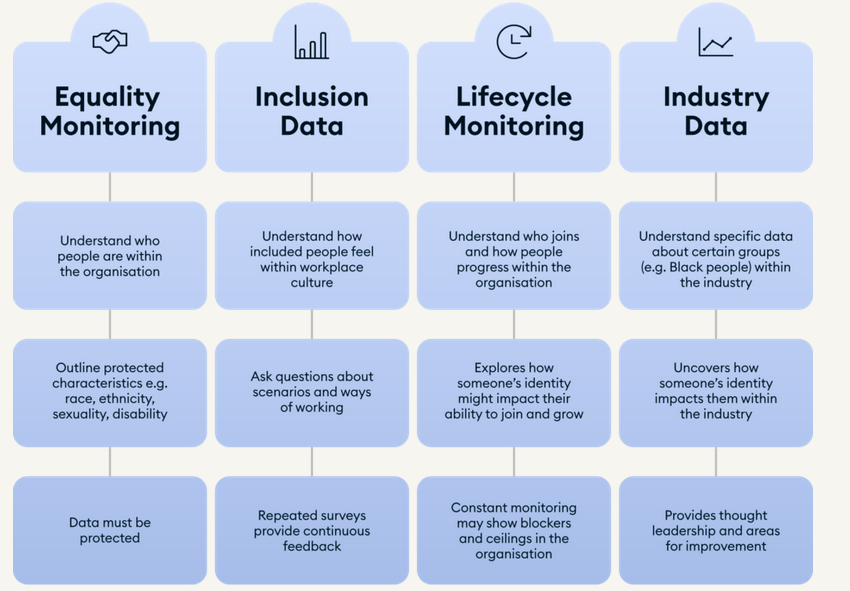'Representation is a measure of diversity. The employee experience is a measure of inclusion', Culture Amp.
Employer recommendations
Simply counting the number of employees from underrepresented groups does not provide a measure of inclusive experience. To measure inclusion organisations must measure the employee experience of different groups and compare the favourability scores between groups (ideally, intersectionally). 'Measuring diversity is generally more straightforward, with the exception of self-identification disclosures, while measuring inclusion requires leaders to observe factors that go beyond employee demographic data; therefore, the elements that comprise inclusion are harder to determine. However, the case for inclusion is strong. Critical talent outcomes, such as employee performance, employee engagement and intent to stay, depend on high levels of inclusion', Gartner.
There are various ways to measure inclusion and some of these are included below from CIPD, Diversio, Gartner and McKinsey.
CIPD provide the following suggestions to measure inclusion:
- Create a bespoke survey to collect inclusion data, measuring individual-level perceptions of inclusion at multiple levels. Find out more about how to measure inclusion in the CIPD report, Building inclusive workplaces.
- Add inclusion questions to existing organisational surveys on key areas of inclusion.
- Make use of existing data, such as culture and engagement surveys, which may already touch on practices related to inclusion.
- Run focus groups or employee feedback sessions to get an employee view on practices, policies and organisational norms.
- Analyse existing workforce data to uncover barriers to inclusion. For example, compare promotion rates between demographic groups or 360-degree feedback data to understand employee and line manager behaviours related to inclusion.
Diversio recommend five characteristics to measure how inclusive an organisation's culture is:
- Inclusive culture: ask employees whether their opinion is sought and valued by their teams
- Fair management: ask whether employees have experienced bias in manager
feedback or reviews. - Career development: ask whether employees have a senior leader who is invested in their success.
- Flexible work options: ask employees if they feel they have the flexibility needed to balance work and home obligations.
- Safe work environment: ask employees whether they have experienced any form of harassment in the workplace.
Gartner have identified seven main drivers of inclusion in an organisation:
-
Fair treatment — Employees at my organisation who help the organization achieve its strategic objectives are rewarded and recognised fairly.
-
Integrating differences — Employees at my organisation respect and value each other’s opinions.
-
Decision making — Members of my team fairly consider ideas and suggestions offered by other team members.
-
Psychological safety — I feel welcome to express my true feelings at work.
-
Trust — Communication we receive from the organisation is honest and open.
-
Belonging — People in my organisation care about me.
-
Diversity* — Managers at my organisation are as diverse as the broader workforce.*Diversity is included as a driver of inclusion because these two concepts are very closely interrelated and thus are co-dependent to achieving successful outcomes.
McKinsey's inclusion model (see image below) covers two key employee elements.
- Personal experience which captures how employees individually experience belonging, whether they feel encouraged to bring their full, authentic selves to work, and how empowered they are to make meaningful contributions.
- Enterprise perception which captures how employees view the strength of acceptance, camaraderie, and fairness across the full enterprise.
'Comparing these two elements can highlight discrepancies that may occur between them. For example, an employee may perceive that an organisation broadly has the systems in place to facilitate inclusion (e.g., fair and unbiased performance evaluations) while simultaneously feeling that they are not personally included (e.g., not having a voice in team decisions)'.

Potential pitfalls when measuring inclusion include:
- Neglecting to share the actions taken in result of employee surveys.
- Not using the data to address issues. After measurement, the next step must be to strategically identify solutions that will address weaknesses efficiently and effectively.
- Conflating inclusion with diversity — we should not assume a high level of diversity in an organisation or business unit necessarily means there is a high level of inclusion.
- Employees don't trust the data collection process or that their responses will be completely anonymous.
- Long and/or frequent surveys. Keep surveys succinct to avoid survey and D&I fatigue.
- Not providing an opportunity for employees to provide free text responses to an open question about their experience.
Tech Nation have helpfully broken down the different types of D&I data into a diagram:

Further information
- Article: 50+ Examples of DEI Scorecards and DEI Reports
- Article: How to Measure Diversity, Equity and Inclusion, Gartner (paid subscription required)
- Whitepaper: How to Measure Inclusion at Your Organization, Diversio
- Article: Inclusion doesn’t happen by accident: Measuring inclusion in a way that matters, McKinsey
- Article: How to Measure Inclusion in the Workplace, Harvard Business Review
- Video: TTC Signatory Forum - DEI data disclosure, Tech Talent Charter
- Report: Building inclusive workplaces, CIPD
- Guide: 5 steps to building your first Diversity & Inclusion Report, Culture Amp
- Guide: Inclusion Measurement Guide, Financial Services Skills Commission
- Resource: Diversity, Equity and Inclusion Metrics to Track and Report, Gartner
